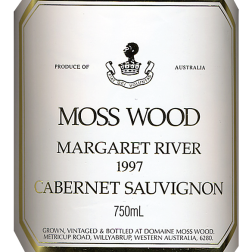Moss Wood 1997 Cabernet Sauvignon
Wine Facts
| Harvested: | 18/3/1997 |
| Bottled: | 18/8/1999 |
| Released: | 2/7/2000 |
| Yield: | 7.00 t/ha |
| Baume: | 13.60 |
| Alcohol: | 14.00% |
| Vintage Rating: | 8/10 |
SOLD OUT
Moss Wood 2022 Cabernet Sauvignon – The Cellar Post
Beautiful definition and purity on the nose that shows fresh cassis, blackberries, and black plum, with cedar, pencil shavings, subtle vanilla and mocha nuances. Medium-full, superb freshness and concentration on the palate, dark fruit with a vibrant streak of purple, excellent oak spice, clove and tobacco, firm tannins and vibrant…
Tasting Notes
The 1997 Moss Wood Cabernet Sauvignon has attractive mulberry and redcurrant perfumes with overtones of spicy, charry oak. Its palate is smooth, round and generous, with rich, sweet fruit, mulberry, plum and mint characters and some tarry earthiness. Although having the body and structure to age, it has the fruit weight and concentration of flavour which enables its tannins to appear soft and neatly balanced. We are particularily pleased with the wine.
Vintage Notes
After the difficulties of the vintage, the 1997 Moss Wood Cabernet is something of a surprise packet. The spring of 1996 was as severe a test of the Margaret River vigneron's patience and optimism as that of 1980 which preceded the 1981 vintage. The vines were subjected to terrible wind and hail damage during spring. This miserable cold, windy and rainy season saved its worst for the hail storm of December 11th which cleaned out the Moss Wood pinot and one third of the cabernet block. The change from cold to warm conditions came on overnight (on New Year's Eve) when the cold and windy December 30th (with its maximum of 22 degrees C) was transformed into a sunny, windless 36 degrees C day before a 40.5 degrees C New Year's Day. On the following day, it was 34 degrees C by 8.30am and only an early sea breeze kept the maximum temperature to 38 degrees C. The warm spell continued until mid January at which time it eased a little. The weather had turned again by the end of January and it rained as the pinot was about to be picked in early February.
After this topsy turvy growing season, the Margaret River area was blessed by lovely weather until mid April. Come picking time, however, it seemed that everyone was irritable. The pickers because it was harder to fill buckets with so small a crop: the winery team because we didn't have as much fruit as needed. The vineyard area that had produced 91 tonnes in 1991 only yielded 50 tonnes in 1997. Despite all the vagaries of the season, quality was not an issue. The difficulties of spring reminded us of 1981 and 1986 with their reduced crops. However the wine is not as tannic as the 1981 (which still shows a powerful steely structure) nor the 1986 (which appears dense, full bodied and strongly tannic).
Production Notes
The 1997 Cabernet was made according to what has become established practice at Moss Wood. The fruit was picked, crushed, de-stemmed and tipped into open tanks after which it was seeded with pure yeast culture. Fermentation took place over seven days at high temperatures (reaching a maximum of 30 degrees C). During this time, the juice remained on its skins and was hand plunged four times a day. Towards the end of the fermentation process, each batch was pumped over once to improve colour and remove any hydrogen sulphide.
It was settled in stainless steel tanks and left on its gross lees so that it could complete its malolactic fermentation. After that it was transferred into barrels (50% new French oak and 50% two and three year old barrels) at the end of May. After a leisurely two years, it was racked from the barrels in June 1999, bottled in July to be released onto the market a year later. This is the third year in which Moss Wood has made all of its Cabernet according to the style kept for its Reserve wines before 1995. It is now allowed two years in barrel (rather than 18 months) and 12 (rather than 6) months for bottle maturation. We are looking for complexity - some smokey, tarry, earthy secondary or developed characters from the longer oak ageing - and is not concerned if some of the wine's fresh, fruity primary characters are subdued by the process.
Cellaring Notes
Many will enjoy its early drinkability. However, we, are confident that it has the potential to benefit from up to fifteen years cellaring.


